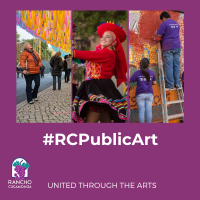Public Art Survey
Public Art Survey
"Art is the highest expression of the human spirit."
- Joyce Carol Oats
Welcome! The City of Rancho Cucamonga is developing its first Public Art & Placemaking Strategic Plan. The goal is to provide community-driven guidelines for implementing public art projects and creative placemaking programs across our city in meaningful and engaging ways. Your voice is critical to this process. We want to know how public art and placemaking projects can shape our community into the future. We want to hear from you!
We welcome your input on these five key topics:
1) Tell us what you value the most
2) Identify the cultural resources in our community
3) Explore types of public art
4) Identify locations for public art
5) Envision the future for public art in our community
Your responses will be collected, analyzed, and documented in a community report. The findings will be used to inform discussions with the Public Art Committee and future stakeholder/affinity groups to include you and the greater community. Ultimately, recommendations will be brought to the City Council by the Public Art Committee for potential adoption in the Public Art & Placemaking Strategic Plan.
See project sidebar for FAQs and informational videos (located to the right on a desktop or at the bottom of the survey on a mobile device).
For more information on the public art planning process, visit www.cityofrc.us/PublicArt
Tell us a little bit about you!
We want to ensure that all of Rancho Cucamonga's diverse voices are represented. Be sure to scroll to the end and click on the submit button to ensure that your responses get submitted.
Thank you for participating! Your feedback is essential for creating a vibrant and functional public art and placemaking plan for Rancho Cucamonga. For more information, please visit https://www.cityofrc.us/PublicArt
Frequently Asked Questions
"Simply put public art is art in public spaces. The term "public art" may conjure images of historic bronze statues of a soldier on horseback in a park. Today, public art can take a wide range of forms, size, and scales - and can be temporary or permanent. It often interprets the history of the place, its people, and perhaps addresses a social or environmental issue. Public art can include murals, sculpture, memorials, integrated architectural or landscape architectural work, community art, digital new media, and even performances and festivals!" - Americans for the Arts
"In creative placemaking, partners from public, private, nonprofit, and community sectors strategically shape the physical and social character of a neighborhood, town, tribe, city, or region around arts and cultural activities. Creative placemaking animates public and private spaces, rejuvenates structures and streetscapes, improves local business viability and public safety, and brings diverse people together to celebrate, inspire, and be inspired." - Ann Markusen and Anne Gadwa "Creative Placemaking" Washington, DC: Mayors' Institute on City Design and the National Endowment for the Arts, October 2010
"Placekeeping as the active care and maintenance of a place and its social fabric by the people who live and work there. It is not just preserving buildings but keeping the cultural memories associated with a locale alive, while supporting the ability of local people to maintain their way of life as they choose." - US Department of Arts and Culture
